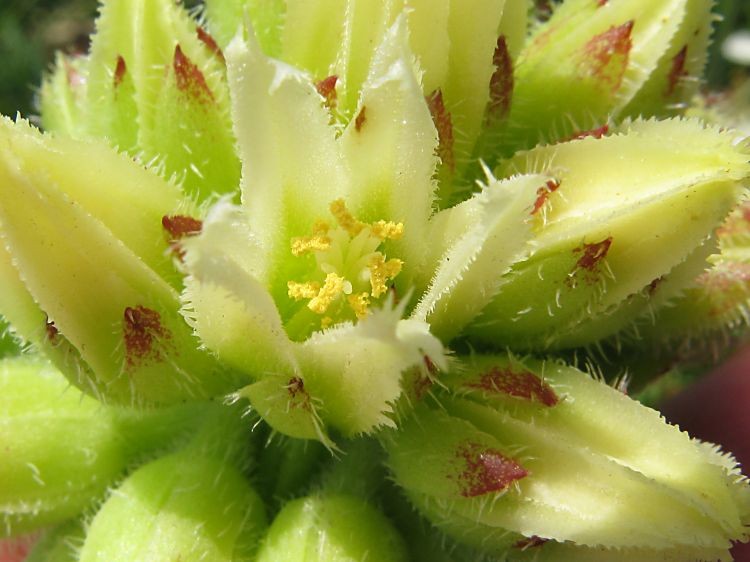Purple Haze
(Sempervivum heuffelii)

Description
Jovibarba heuffelii (Syn. Sempervivum heuffelii) common name Hen-and-chickens, as a plant species native to the Balkans and to the Carpathians in Europe but reportedly naturalized in Wisconsin and probably in other parts of North America. It grows on rocky outcrops. Jovibarba heuffelii is a perennial herb forming basal rosettes of succulent leaves that are ciliate along the margins. Flowering stalks are erect, succulent, up to 20 cm (8 inches) tall, bearing a cyme of up to 40 white to yellowish flowers. Each flower is up to 5 cm (2 inches) in diameter, with 6-7 fringed petals. Each plant is semelparous, meaning that it flowers only once, dying after its fruits mature. Some botanists treat the genus Jovibarba as part of the genus Sempervivum, but the Flora of North America separates it into its own genus. Sempervivum is a genus of about 40 species of flowering plants in the family Crassulaceae, commonly known as houseleeks. Other common names include liveforever (the source of the taxonomical designation Sempervivum, literally "always/forever alive") and hen and chicks, a name shared with plants of other genera as well. They are succulent perennials forming mats composed of tufted leaves in rosettes. In favourable conditions they spread rapidly via offsets, and several species are valued in cultivation as groundcover for dry, sunny locations. Houseleeks exist from Morocco to Iran, through the mountains of Iberia, the Alps, Carpathians, Balkan mountains, Turkey, the Armenian mountains, in the northeastern part of the Sahara Desert, and the Caucasus. Their ability to store water in their thick leaves allows them to live on sunny rocks and stony places in the mountain, subalpine and alpine belts. Most are hardy to US zone 4, and will handle warm climates to about zone 9. It has been used historically and is used presently for purported health benefits. It has no known side effects (aside from being an emetic in large doses) or drug interactions. Common herbal uses are stopping bad cases of diarrhea by drinking the juice of the leaf or eating the leaves directly, and the juice is commonly applied directly to the skin for many of the same uses as aloe vera such as burns, warts and insect bites. It is furthermore said to bring relief in cases of swellings and water retention.
Taxonomic tree:







